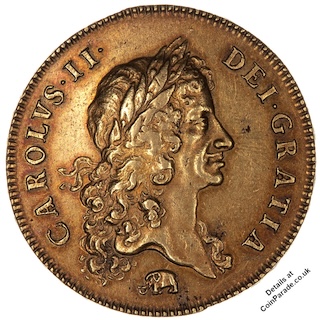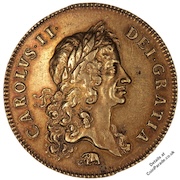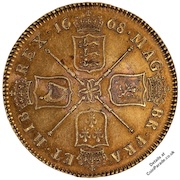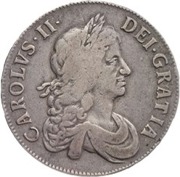
 The 1668 Gold Five Guinea Charles II (First Bust, Elephant, 3329)
The 1668 Gold Five Guinea Charles II (First Bust, Elephant, 3329)The 1668 Five Guinea of King Charles II was minted in gold, and on this coin there is a small elephant under the bust that indicates the gold came from the African Company who mined for gold in Guinea in Africa, hence the name of the coin. SCBC 3329.
Gold Five Guinea coins minted in 1668 could have gold from another source so coins were also issued without the elephant (SCBC 3328).
The coin shows the designs of John Roettier and were minted using the new mill and screw machines of Peter Blondeau at the Tower Mint (Royal Mint, London). Diameter 36.5mm, weight 41.8g.
The Guinea originally had a value of one pound (20 shillings), and it was only later it attained the more accepted value of 21 shillings. The 1668 Gold Five Guinea is a rare and expensive coin, and you could be looking at £10,000 to £100,000 according to condition.
The Obverse shows the first laureated bust of King Charles II, facing right. Elephant below. Legend "CAROLVS.II.DEI.GRATIA" (Charles II by the Grace of God).
Edge has raised lettering which includes the Regnal Date (showing the year of reign). Text is "+ DECVS ET TVTAMEN ANNO REGNI VICESIMO" meaning an "ornament and a safeguard" plus the regnal date. VICESIMO means the 20th year of reign, as Charles counted his reign from the when his father Charles I died, not from the Reformation date.
 The Reverse shows crowned cruciform coats-of-arms with sceptres in the quarters and a design of four interlocked monograms in the centre. Legend "MAG BR FRA ET HIB REX 1668", showing Charles II was King of England, France, Scotland and Ireland. Date divided at top.
The Reverse shows crowned cruciform coats-of-arms with sceptres in the quarters and a design of four interlocked monograms in the centre. Legend "MAG BR FRA ET HIB REX 1668", showing Charles II was King of England, France, Scotland and Ireland. Date divided at top.Image credit: Museums Victoria
Mintage: Not known
Minted at The Royal Mint
Below are some coins currently being offered on eBay. As an eBay Partner, We may be compensated if you make a purchase.
 Charles II was King of England, Scotland, and Ireland. He was king of Scotland from 1649 until his deposition in 1651, and king of England, Scotland and Ireland from the 1660 Restoration of the monarchy until his death.
Charles II was King of England, Scotland, and Ireland. He was king of Scotland from 1649 until his deposition in 1651, and king of England, Scotland and Ireland from the 1660 Restoration of the monarchy until his death.The reign of Charles II is an interesting period for coin collectors. Charles issued many coins. When his father, King Charles I was executed, Charles II was forced into exile and Civil War raged in England. The first coins were those of Charles I, issued in the name of Charles II, minted around the country to pay armies. After the Reformation of the Monarchy, Charles II issued his own coins and from 1670 hammered coins were gradually replaced with milled coins.
The regnal years used on Charles II coins were:
1668:VICESIMO; 1669:VICESIMO PRIMO; 1670:VICESIMO SECVNDO; 1671:VICESIMO TERTIO; 1672:VICESIMO QVARTO; 1673:VICESIMO QVINTO; 1674:VICESIMO SEXTO; 1675:VICESIMO SEPTIMO; 1676:VICESIMO OCTAVO; 1677:VICESIMO NONO; 1678:TRICESIMO; 1679:TRICESIMO PRIMO; 1680:TRICESIMO SECVNDO; 1681:TRICESIMO TERTIO; 1682:TRICESIMO QVARTO; 1683:TRICESIMO QVINTO; 1684:TRICESIMO SEXTO.
Charles II coins usually use the latin spelling: Carolus II.
The Guinea is a famous British gold coin minted between 1663 and 1814. The coin was originally created as a one pound coin (20 shillings) but is better known as being worth One Pound and One Shilling (21 shillings).
After the English Civil War, King Charles II introduced new coinage. A gold coin, approximately a quarter of an ounce, was issued and for the first time it was not hammered. Made by machine using gold from the Guinea Coast of West Africa the coin probably became the most important coin of the realm.
Originally 20 shillings, the coin actually fluctuated with the gold price, at times being as high as 30 shillings. In 1717 the Guinea became fixed at 21 shillings (in today’s money that is £1.05). Other coins of the family were also minted, such as half-guinea, two-guinea and five-guinea.
The design of gold guinea changed dramatically over the years, from depictions of crowned cruciform shields to the ‘Spade’ shaped crowned shields of arms.
In the Great Recoinage of 1816 the Guinea was replaced by the Pound and the Sovereign became the gold coin in use. The last guinea was issued during the reign of King George III in 1813. That particular coin is known as a ‘Military’ guinea, as it was specially struck to pay British troops at the time of the Napoleonic Wars.
Long after the Guinea was retired the name continued to be used, especially for prestige purchases intended for the more wealthy. Even now racehorses are still sold in Guineas (the auctioneer traditionally taking the 5p as commission).
Guineas are 25mm in diameter, weigh about 8.38g and are 22 carat gold (91.6%). Prior to 1717 they weighed slightly less (around 8.3g) and were made of 91.34% gold.
Millions of gold guineas were minted and widely circulated, so often turn up in fine to very fine condition. As with all coin types, some years are much rarer than others, such as the 1761 guinea (as it was the first guinea minted during the reign of King George III).
Formed in the reign of Alfred the Great about the year 886, during the period 1279-1812 it was generally referred to as The Tower Mint as it was housed at the Tower of London. The Master of The Royal Mint has included famous figures such as Sir Isaac Newton.
Since 2010 it has operated as Royal Mint Ltd, a company owned by HM Treasury, under an exclusive contract to supply all coinage for the UK although it also produces medals and coins for other countries. It is currently located at Llantrisant, Wales.
The orignal coinage was Pounds, Shillings and Pence but since decimalisation on 15 February 1971, it is £1 = 100p, that is One Pound = 100 pence. The coinage of the UK is also a long history, the Royal Mint being established as long ago as 886AD when coins were hammered. Today there is perhaps 30 billion coins in circulation, and many (numismatic) collectors coins and sets are issued frequently in gold, silver and other metals.








